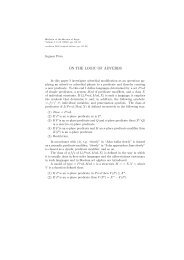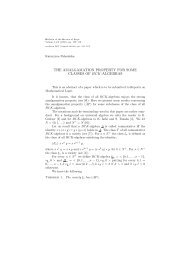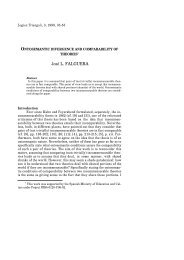Luis VILLEGAS-FORERO, Janusz MACIASZEK
Luis VILLEGAS-FORERO, Janusz MACIASZEK
Luis VILLEGAS-FORERO, Janusz MACIASZEK
You also want an ePaper? Increase the reach of your titles
YUMPU automatically turns print PDFs into web optimized ePapers that Google loves.
138 LUIS <strong>VILLEGAS</strong>-<strong>FORERO</strong>, JANUSZ <strong>MACIASZEK</strong><br />
language determiners. The application of the permutational invariance<br />
criterion was possible in [22] because the quantifiers were treated categorematically,<br />
i.e. as the members of an appropriate syntactical category<br />
for those of the first-order language. The criterion permitted not<br />
only the introduction of the quantifiers definable in first-order language<br />
with identity, but also the introduction of some indefinable quantifiers,<br />
e.g. “for finitely many”. The criterion of permutational invariance was<br />
then adopted by Per Lindstrom ([16]) who extended the notion of quantifier<br />
by introducing quantifiers of various types into the first-order language.<br />
Some years later the same criterion was used by Timothy<br />
McCarthy ([19]) to show that all logical expressions of the standard<br />
first-order language are permutation invariants. Tarski's final version of<br />
the criterion with the application to the entities of various categories<br />
was formulated in 1966, but it remained practically unknown until its<br />
publication by John Corcoran twenty years later.<br />
The Mostowski-Tarski criterion turned out to be extremely useful<br />
in finding the “logical core” of natural languages, and especially in those<br />
parts that cannot be expressed in the first-order language of logic. The<br />
model-theoretic approach to the semantics of natural language has been<br />
systematically initiated by Montague in the early seventies. Determiners<br />
such as e.g. “all”, “some”, “a”, “the”, “for at least seven”, or “for exactly<br />
three” were strictly translated by corresponding quantifiers of the<br />
first-order language with the aid of the lambda operator and the typed<br />
intensional logic. But, though Montague's results in model-theoretic<br />
semantics of natural language are recognised as very important and innovative,<br />
he did not formulate the criteria of logicality. The permutation<br />
invariance was used in 1981 in Barwise and Cooper's article<br />
“Generalized Quantifiers in Natural Language” ([2]). This paper has<br />
initiated very intensive investigations on natural language determiners,<br />
their various classifications and types of monotonicity. This classification<br />
helped to find “logical gaps” in natural language, i.e. to find entities<br />
which are possible denotations of non-existing determiners. The most<br />
significant papers on the topic are written by van Benthem ([33] and<br />
[35]), Westertahl ([37]) and Keenan and Stavi ([13]). The Mostowski-<br />
Tarski criterion has been gradually recognised as the necessary condition<br />
not only for the logicality of quantifiers or determiners, but for expressions<br />
of other categories as well. In particular, Westertahl [38] and van<br />
Benthem [34] sought the logical items of various types as the possible<br />
denotations of logical expressions of different categories of natural language.<br />
Their results concerning logical entities of different types are<br />
very similar to those obtained in our paper. The difference lies in the<br />
kind of semantics (formal ontology) that has been applied. Our use of






